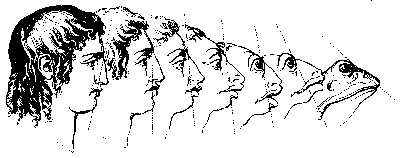 |
 |
 |
 |

The first systematic investigation of the anatomical differences between apes and humans came in 1699, when Edward Tyson, the most important founder of primatoogy, dissected both human beings and chimpanzees and pointed out their points of divergence in Orang-Outang, sive Homo sylvestris: or the anatomy of a pygmy compared to that of a monkey, an ape, and a man, to which is added a philological essay concerning the pygmies, the cynocephali, the satyrs, and sphinges of the ancients.
The work of describing, classifying, and distinguishing human beings and other primates was carried on in the eighteenth and early nineteenth centuries by Buffon (in Varieties of the Human Species, 1749), Lamarck, and Baron Cuvier. But the most important person in the field, often considered the founder of physical anthropology, is Johann Friedrich Blumenbach.
Blumenbach was a disciple of Linnaeus, and inherited his method of classifying living things, but differed from him in a number of important respects. Whereas Linnaeus classified human beings with the other primates, Blumenbach separated them into two orders. In On the Natural Variety of Mankind (1775), he rejected Linnaeus's habit of using personality traits and cultural characteristics in classifying humans, preferring to place the emphasis entirely on anatomy. From this research, Blumenbach became convinced that "innumerable varieties of mankind run into each other by insensible degrees."
Early physical anthropology is often marked by the tendency to conflate cultural and biological characteristics; science was often crowded out by ethnocentricity. Much eighteenth- and nineteenth-century research into physical anthropology made unsupportable generalizations about human races, falling into two camps: monogenists like Blumenbach, who argued that all human beings shared a single origin in Adam and Eve; and polygenists, who argued for a different Adam and Eve for each race. The various races were ranked in a scala naturae, a scale of nature, in which the most intelligent races represented the pinnacle of evolution.
The scala naturae is evident in the physical anthropology of Carl Linnaeus. In the revised tenth edition of Systema naturae of 1758, Linnaeus suggested a system of racial classification with seven races, and gave the characteristics of each: the white Europaeus was "sanguine" and "muscular"; the sallow Asiaticus was "melancholy" and "stiff"; the red Americanus was "choleric" and "upright"; the black Afer was "phlegmatic" and "relaxed"; the wild and hirsute Ferus ran about on all fours; the Troglodyte; and what could not be classified otherwas (such as giants and genetic mutants) was relegated to the category of the Monstrous.
Blumenbach's emphasis on anatomy rather than cultural characteristics caused him to differ from Linnaeus on these questions: he rejected Linnaeus's Ferus and Troglodyte, but added a Malayan race for the inhabitants of Southeast Asia. (His revised system consisted of Caucasoid [White], Mongoloid [Yellow], American [Red], Ethiopian [Black], and Malayan [Brown].) But the ranking of the races according to their excellence is still as explicit in his work as in Linnaeus's: he considered a skull from the Caucusus mountains the perfect European form, and regarded the other four races as examples of degeneration from European perfection.